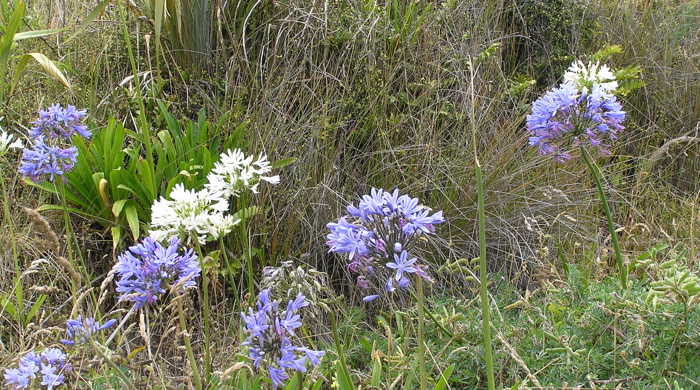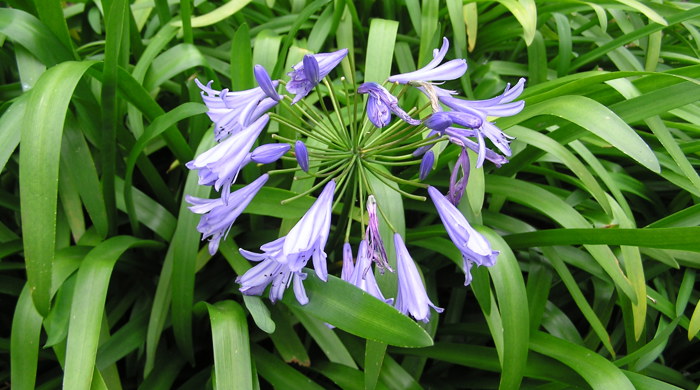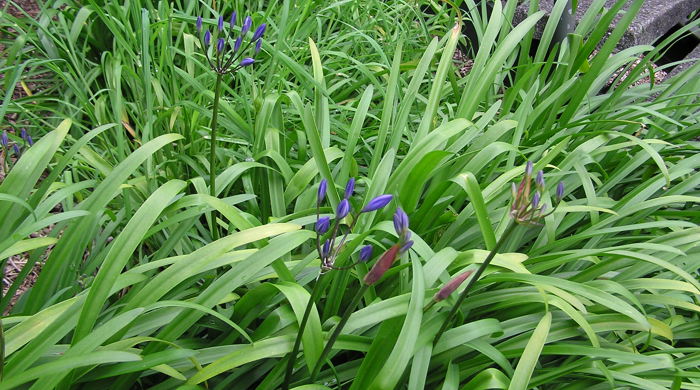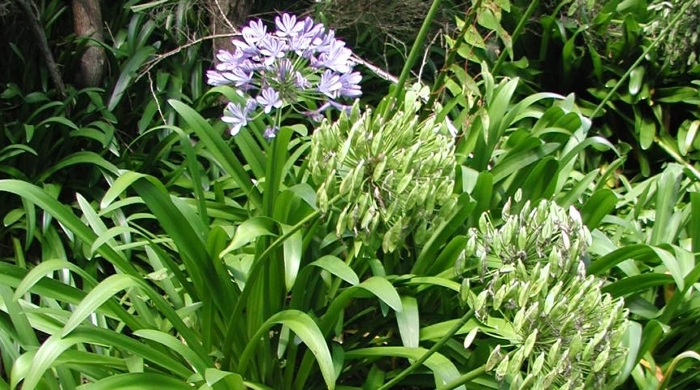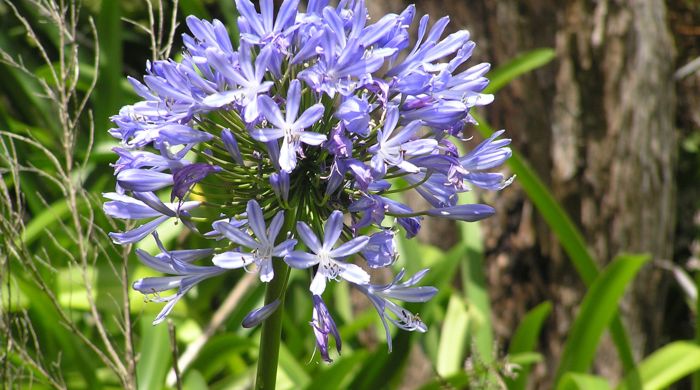Agapanthus praecox
Agapanthus
Also known as:
Agapanthus orientalis
Family: Liliaceae
Origin: South Africa
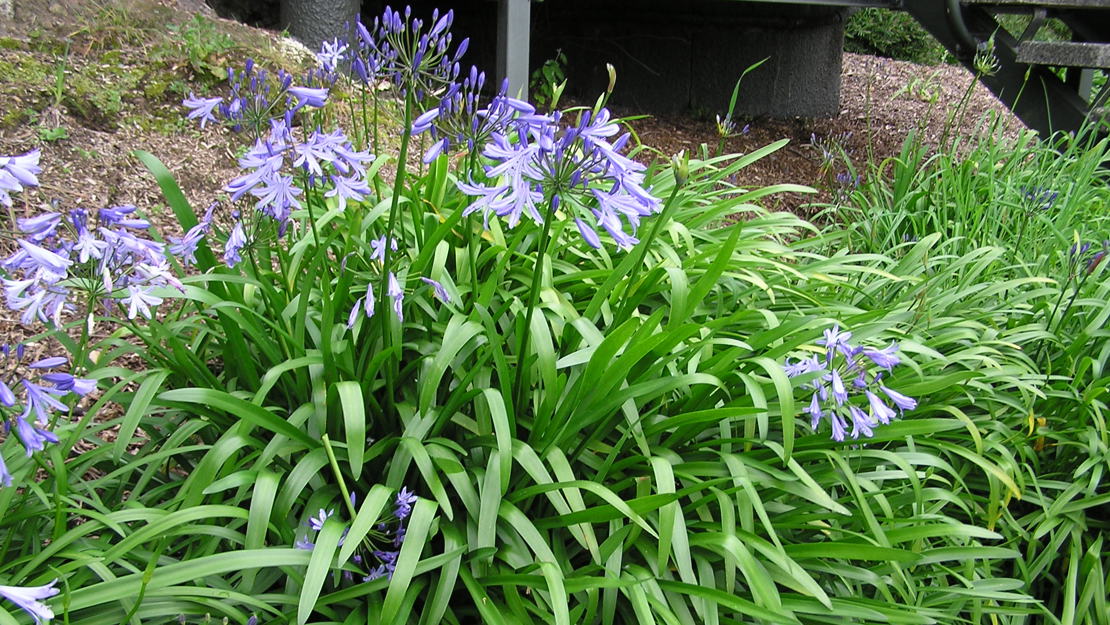
Regional Pest Management Plan (RPMP) status
- Parkland with Significant Ecological Areas — Site-led (on-park and buffer)
- Whole region — Sustained control
- Waitākere Ranges Heritage Area priority status
- Hauraki Gulf Controlled Area Notice pest
General description
Agapanthus is here defined as all Agapanthus praecox tall form cultivars (those exceeding 60 cm height). After the RPMP has been operational for 2 years, this definition will be expanded to include all Agapanthus praecox cultivars, except those determined by Auckland Council to be low fertility cultivars. Low fertility cultivars are listed on the Auckland Botanic Gardens website.
Perennial evergreen herb < 1.2 m tall. Leaves are leathery, arching and arise from the base in clumps. Flowers are white/blue/purple and are borne in terminal umbels on erect stems in December – February. Seed capsules are three-sided and contain thin, black, papery seeds.
What you need to know
To help protect our environment:
- You must not breed, distribute, release or sell agapanthus within the Auckland region. Prior to 1 September 2023, this restriction applies only to tall form cultivars (those exceeding 600mm height). From 1 September 2023, the restriction will apply to all cultivars except for any low fertility cultivar which is determined by Auckland Council to produce less than 2% viable sees compared with high fertility cultivars that were evaluated under the same conditions and location. Cultivars already meeting this test are:
- A. ‘Agapetite’
- A. 'Baby Pete'
- A. ‘Blue Finn’ (syn. 'Ecostorm')
- A. ‘Blue Ice’
- A. ‘Dorothy Edwards’
- A. 'Finn'
- A. 'Goldstrike'
- A. 'Kath'
- A. 'Mini Me'
- A. 'Pavlova'
- A. 'Rachel'
- A. 'Sarah'
- A. 'Sea Foam'*
- A. ‘Snowdrops’*
- A. ‘Surprise Storm’
- A. ‘Thunder Storm’ (syn. A. ‘Thunderstorm’)
*There are some plants in circulation under this name but with high seed set – these do not match the cultivar we tested and are likely to have been misnamed.
List updated January 2025.
- Find out more about the testing process on the Auckland Botanic Gardens website.
- You must not plant agapanthus within the Auckland region, unless you are transferring an existing plant on your land to another location within the boundaries of the same property. Prior to 1 September 2023, this restriction applies only to tall form cultivars (those exceeding 600mm height). From 1 September 2023, the restriction will apply to all cultivars except for any low fertility cultivar which is determined by Auckland Council to produce less than 2% viable sees compared with high fertility cultivars that were evaluated under the same conditions and location. Cultivars already meeting this test will be listed on the Auckland Botanic Gardens website.
- You must destroy any agapanthus on land that you occupy if it has been planted in breach of the above rules and you are directed to do so by an authorised person.
Transport corridor operators must destroy all agapanthus before it sets seed on any transport land that is located within the buffer area of a park where agapanthus is being managed. View a map of park buffers where this applies.
To find out more about how we’re protecting Auckland’s parkland from pest plants, visit our pest plant buffer pages.
Habitats
Open habitat, disturbed sites, coastal ecosystems, rocky sites, roadsides, forest and riparian margins, canopy gaps, sand dunes, ditches.
Dispersal
Seeds dispersed by wind, gravity and water. Vegetative spread from rhizome fragments. Human-mediated dispersal through dumping of garden waste and deliberate plantings.
Impact on environment
Forms dense infestations that exclude native vegetation, especially in coastal areas. Toxic if ingested. Contact allergens can cause rashes, burning sensations and mouth ulcerations, especially in children.
Control
Site Management
Follow up treated areas 3 times per year. Encourage natural regeneration of native plants or replant treated areas where possible after 2-3 treatments to establish dense ground cover and minimise reinvasion.
Recommended approaches
Physical control
Method: Dig out and cut off seed heads.
Plant parts requiring disposal: Seed heads if practical and rhizomes.
Disposal options: Small amounts can be rotted in a covered water barrel or remove to greenwaste or landfill.
Biocontrol
Biocontrol is currently not available for this species.
Community agrichemical control recommendations
No qualifications: Cut stump and paste freshly cut base of stems with double strength glyphosate gel.
Basic Growsafe certified: Cut stump and spray freshly cut base with 250ml glyphosate green per 1L of water.
Certified Handler/Experienced agrichemical user: Foliar spray with 60ml triclopyr per 10 Litres of water and 20ml penetrant.
Caution: When using any herbicide or pesticide please read the label thoroughly to ensure that all instructions and safety requirements are followed.
